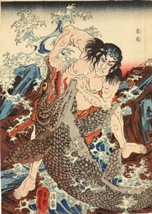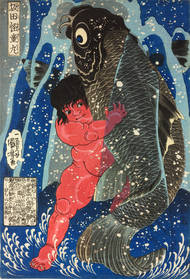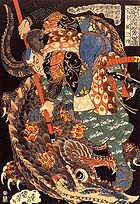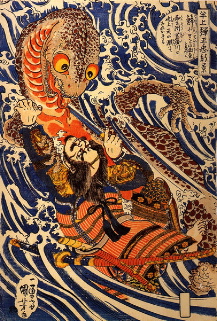Kuniyoshi in London
Posted by: Loren Coleman on March 23rd, 2009
Utagawa Kuniyoshi (Japanese: 歌川国芳) (ca. 1797 – April 14, 1861) was one of the last great masters of the Japanese ukiyo-e style of woodblock prints and painting and belonged to the Utagawa school.

Asahina Saburô Yoshihide Wrestles with Two Crocodiles at Kotsubo Beach, Kamakura, 1849 Color woodblock, õban triptych (left sheet), by Utagawa Kuniyoshi.
His art contains giant salamanders, giant carp, and several other types of animal imagery of interest to cryptozoologists. His attention to human-animal encounters in unusual situations and locations is a focus of cryptozoological study.
A new exhibition, “Kuniyoshi: From the Arthur R. Miller Collection,” will be held from 21 Mar—7 Jun 2009, in the Sackler Wing of Galleries at the London Royal Academy of Arts.

Sakata Kaidō-maru wrestles with a giant carp, c. 1837. Color woodblock, ōban, 37.8 x 26 cm. by Utagawa Kuniyoshi.

Miyamoto Musashi Killing a Giant Nue (a legendary creature found in Japanese folklore, thus a cryptid). What was this Giant Nue?

Hanagami Danjo No Jo Arakage Fighting A Giant Salamander

Tamatori, the Diving Girl, stabbing an octopus.
The Royal Academy of Arts presents an exhibition on one of the greatest Japanese print artists, Utagawa Kuniyoshi (1797-1861). Featuring over 150 works, the exhibition presents Kuniyoshi as a master of imaginative design. It reveals the graphic power and beauty of his prints across an unprecedented range of subjects highlighting his ingenious use of the triptych format.
The majority of the exhibition has been drawn from the outstanding collection of Professor Arthur R. Miller which has recently been donated to the American Friends of the British Museum. This is the first major exhibition in the United Kingdom on Utagawa Kuniyoshi since 1961.
Kuniyoshi was a major master of the ‘floating world’, or Ukiyo-e school of Japanese art, and, together with Katsushika Hokusai (1760-1849), Utagawa Hiroshige (1797-1858) and Utagawa Kunisada (1786-1864), dominated nineteenth century printmaking in Japan. Prolific and multitalented, Kuniyoshi considerably expanded the existing repertoire of the school, particularly with thousands of designs that brought vividly to life famous military exploits in Japan and China. Kuniyoshi developed an extraordinarily powerful and imaginative style in his prints, often spreading a scene dynamically across all three sheets of the traditional triptych format and linking the composition with one bold unifying element – a major artistic innovation.
Kuniyoshi is the third exhibition in a series dedicated to Japanese Artists and Printmakers to be held at the Royal Academy of Arts. The previous exhibitions have been Hokusai (1991-92) and Hiroshige: Images of Mist, Rain, Moon and Snow (1997).
This exhibition has been organised by the Royal Academy of Arts in collaboration with Arthur R. Miller and The British Museum.
Kuniyoshi is curated by Timothy Clark, Head of the Japanese Section in the Department of Asia at the British Museum together with Japanese print specialist, Israel Goldman and Dr Adrian Locke of the Royal Academy of Arts.
Sponsor’s statement
“Canon is delighted to support this exhibition that shares and celebrates the traditional culture of Japan. As a Japanese company with a long tradition in supporting culture and society through the arts, we are proud to be associated with one of the world’s finest art institutions and one of the greatest Japanese artists, Utagawa Kuniyoshi.”
– James Leipnik, Chief of Communication and Corporate Relations, Canon Europe.
Most museums have corporate sponsors, royal backing, and endowments, while cryptozoology collections just have you. Your support is greatly appreciated, when you…
and you feel great about it!
🙂 Thank You.
About Loren Coleman
Loren Coleman is one of the world’s leading cryptozoologists, some say “the” leading living cryptozoologist. Certainly, he is acknowledged as the current living American researcher and writer who has most popularized cryptozoology in the late 20th and early 21st centuries.
Starting his fieldwork and investigations in 1960, after traveling and trekking extensively in pursuit of cryptozoological mysteries, Coleman began writing to share his experiences in 1969. An honorary member of Ivan T. Sanderson’s Society for the Investigation of the Unexplained in the 1970s, Coleman has been bestowed with similar honorary memberships of the North Idaho College Cryptozoology Club in 1983, and in subsequent years, that of the British Columbia Scientific Cryptozoology Club, CryptoSafari International, and other international organizations. He was also a Life Member and Benefactor of the International Society of Cryptozoology (now-defunct).
Loren Coleman’s daily blog, as a member of the Cryptomundo Team, served as an ongoing avenue of communication for the ever-growing body of cryptozoo news from 2005 through 2013. He returned as an infrequent contributor beginning Halloween week of 2015.
Coleman is the founder in 2003, and current director of the International Cryptozoology Museum in Portland, Maine.










Great post on Japanese artwork of a cryptozoological bent, and it wasn’t even a guest blog by me. 🙂
Kuniyoshi is one of my favorites. I actually have a print of his hanging up in my home (not an original of course). His work is ubiquitous in Japan.
I’m curious of the work labelled as a “Nue” above. The painting of the “Nue” above is interesting to me in that it is not keeping with the traditional appearance of these legendary creatures. The Nue was typically described as being a chimera, having the head of a monkey, the tail of a snake, the legs of a tiger, and the body of a tanuki (racoon dog). Even other works by Kuniyoshi Utagawa depicting Nue look quite a bit different than the one labelled as such above.
Nue were thought to be bringers of bad fortune and sickness and were attributed shapeshifting powers among other things. For instance, they were said to be able to transform into a flying black cloud.
Yes, mystery man, traditionally the Nue is described as a combination creature, with a little of this and a little of that. Anything that involves the raccoon dog, tanuki, certainly is intriguing.
But in this specific print of the Giant Nue by Kuniyoshi, in various reproductions found on the Internet, it is labeled as a “Giant Nue.” Quite interesting considering the apparent reptilian affinities and yet this “animal” looks unlike the crocodilians shown in art I was also able to gather for the same artist.
Ah, it’s a mystery and we like those here.
Very interesting from the perspective of crypto and the history of fine art and culture.
Oh, by the way, I recently came across an image of a small antique ivory netsuke that was on display at the Victoria and Albert Museum. The creature is called a baku, described as a “curious long nosed creature.”
To my eye it looks like a miniature wooly mammoth, with a sinuous trunk, prominent and very elephantine like-tusks and elaborately flowing hair.
Baku. Mythical long-nosed beast. Ivory katabori netsuke, approx. 4.5cm in height. Victoria & Albert Museum.